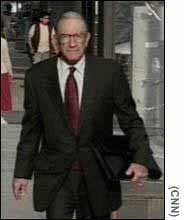|
The Fed's next move
|
 |
August 22, 2001: 2:13 p.m. ET
Is the central bank's 7th rate cut of 2001 the last, or will weakness continue?
By Staff Writer Mark Gongloff
|
NEW YORK (CNNfn) - After the seventh Federal Reserve interest-rate cut of 2001, economists have begun turning their attention to the future – and the possibility of yet another rate cut.
The U.S. central bank cut its target for short-term interest rates from 3.75 percent to 3.5 percent in an effort to keep money flowing through the U.S. economy and avoid a recession, defined as two consecutive quarters of shrinking gross domestic product (GDP).
One reason U.S. stocks fell after the Fed's announcement Tuesday was investor disappointment that the Fed didn't change its current bias toward further rate cuts because it still sees a rocky road ahead for the economy and corporate profits.
Wall Street was hoping for a rosier picture, especially at a time of year when companies are setting their budgets for 2002. But the market has also been known to overreact to news.
"The market seemed to think [the Fed's bias] was a note of panic, but I didn't see that at all," said David Blitzer, chief investment strategist at Standard & Poor's. "It's a note of caution. If the Fed saw a boom coming, it would shift to a neutral bias. I don't think it should scare [companies] completely, but I certainly wouldn't go spend like a drunken sailor."
Click here for more on the Fed and rates
The Fed worries that slow capital spending, which hurts corporate profits, could lead to more job cuts, which could damage consumer spending, which fuels two-thirds of the U.S. economy. So far, consumer spending has held up remarkably well during the year-long slowdown, but signs of weakness could push the Fed to cut rates again after its next policy meeting, scheduled for Oct. 2.
| |

|
|
Fed Chairman Alan Greenspan was unpopular on Wall Street Tuesday, but he may have the economy right where he wants it. | |
"For recovery to have any real oomph, capital spending will need to rebound," said Bruce Steinberg, chief economist at Merrill Lynch. "So far there are no signs of that, and we don't expect a turn until the first half of next year. So in the near term, the economy will probably remain soft enough to justify at least one more Fed move."
According to an Aug. 16 Reuters poll, only 12 of 25 "primary dealers" – investment banks that trade directly with the Fed in fixed-income markets – expected another quarter-percentage-point rate cut by the end of the year. But economists and the Fed will closely watch economic data released in the next six weeks for signs of weakness.
One hopeful sign is that the index of leading economic indicators compiled by the Conference Board, an independent research group, has risen four straight months after several months of decline.
"At each such turning point since 1960, industrial production has risen notably over the succeeding 12 months," said Salomon Smith Barney economist Robert DiClemente. "This period is unlikely to be an exception."
Click here for CNNfn.com's economic calendar
Other recent reports of falling prices, continuing strength in the housing market, a possible recovery in the labor market, and signs that businesses are working off their inventories – meaning they could start to increase production – have led some observers to wonder if the Fed's work is already done.
The Fed has slashed 3 percentage points from short-term rates this year, taxpayers have begun spending advance payments for 2001 tax credits – commonly called "rebates" – and oil and gas prices are falling, meaning the Fed could be reluctant to pump more stimuli into the economy and risk fueling inflation.
"Given these considerations, we believe the Fed is anxious to bring the current easing cycle to an end and will do so as soon as the data point to some economic improvement, however modest," said Henry Willmore, chief economist at Barclays Capital.
Most economists expect a gradual recovery in the second half of the year and GDP growth of between 2 percent and 3 percent in 2002. Unfortunately for the Fed, it might not get enough data between now and Oct. 2 to convince it a recovery is at hand.
"Even though there probably is a recovery in the pipeline, there isn't going to be any clear evidence of it by the time we get around to the next meeting," Bill Cheney, chief economist for John Hancock Financial Advisors, told CNNfn's Money Gang program.
Still, despite the stock market's negative reaction to Tuesday's rate cut and continuing worries about the future, the Fed has the economy right where it wants it, Cheney said. (449K WAV) or (449K AIF) 
|
|
|
|
|
 |

|

